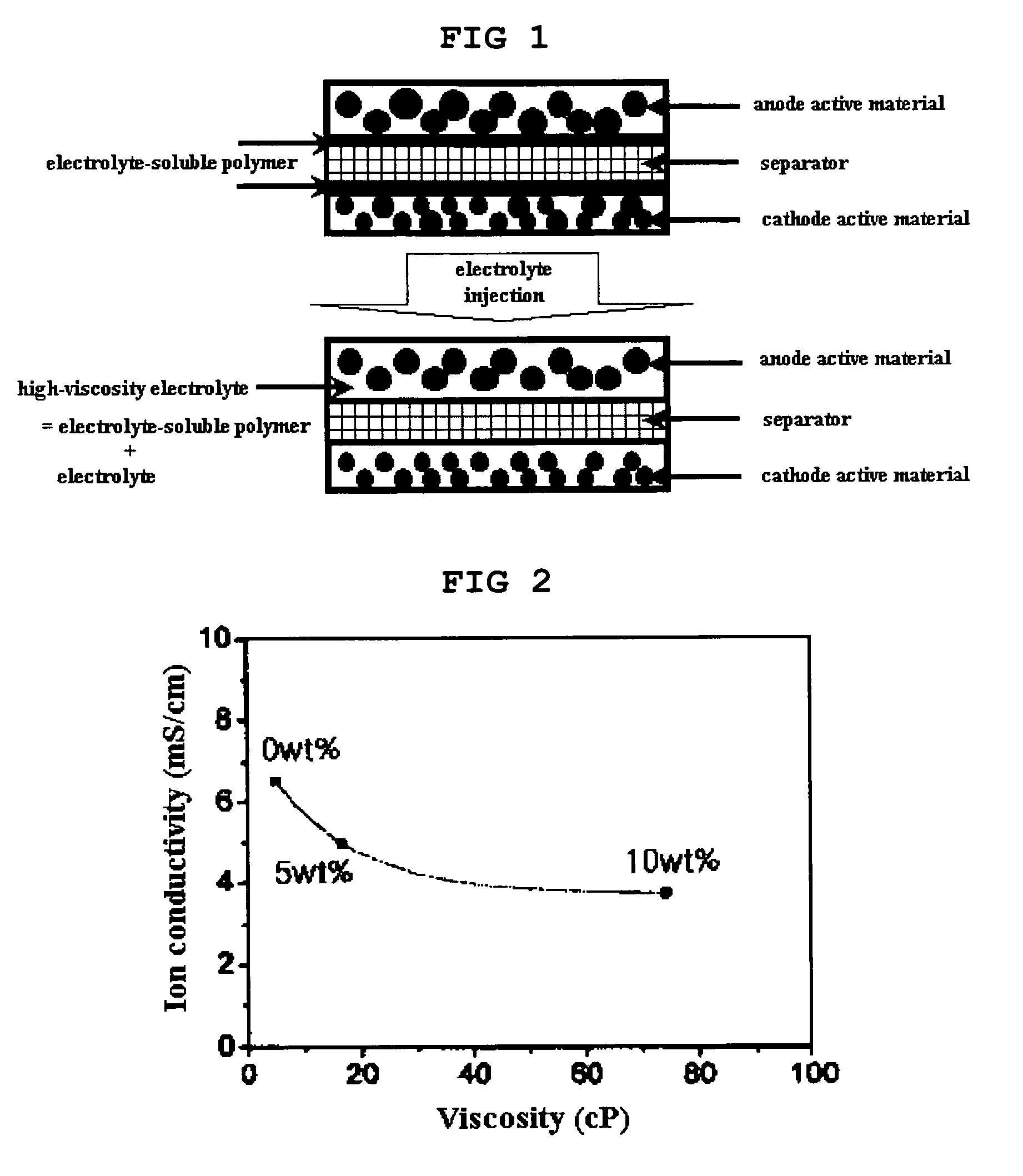Seperator coated with electrolyte-miscible polymer and electrochemical device using the same
a technology of miscible polymer and separator, which is applied in the field of separator, can solve the problems of insufficient discharge capacity, complicated process, and low capacity, and achieve the effects of improving battery safety, preventing deterioration in battery performance, and improving battery safety
- Summary
- Abstract
- Description
- Claims
- Application Information
AI Technical Summary
Benefits of technology
Problems solved by technology
Method used
Image
Examples
reference example 1
Measurement of Viscosity and Ion Conductivity of Electrolyte in Which Electrolyte-Soluble Polymer has been Dissolved
[0052] Changes in the viscosity and ion conductivity of an electrolyte with a change in the concentration of an electrolyte-soluble polymer in the electrolyte were measured. Cyanoethyl pullulan was used as the electrolyte-soluble polymer, and a 3 / 2 / 5 (weight ratio) mixture of EC / PC / DEC with a LiPF6 concentration of 1M was used as the electrolyte. The concentrations of cyanoethyl pullulan in the electrolyte were controlled to 0 wt %, 5 wt % and 10 wt %.
[0053] Changes in the viscosity and ion conductivity of the electrolyte with a change in the concentration of cyanoethyl pullulan were measured, and the measurement results are shown in FIG. 2. As shown in FIG. 2, it could be found that the viscosity of the electrolyte was greatly increased by dissolution of a small amount of the electrolyte-soluble polymer (cyanoethyl pullulan), but there was a very insignificant reduc...
examples 1-2
Production of Separator Coated with Electrolyte-Soluble Polymer and Lithium Secondary Battery Including the Same
example 1
[0054] 1-1) Production of Separator Coated with Cyanoethyl Pullulan
[0055] Cyanoethyl pullulan (degree of polymerization of about 600) was dissolved in acetone, and the solution was coated on the surface of a three-layer separator consisting of polypropylene / polyethylene / polypropylene (PP / PE / PP) by a dip coating method. Then, the coated polymer was dried at ambient temperature and dried in hot air at 100° C. so as to produce a final separator. The thickness of the electrolyte-soluble polymer film coated on the surface of the separator was about 1 μm.
[0056] 1-2) Production of Lithium Secondary Battery
[0057] (Production of Anode)
[0058] Carbon powder as a anode active material, polyvinylidene fluoride (PVDF) as a binder, and carbon black as a conductive material were added to a N-methyl-2-pyrrolidone (NMP) solvent at amounts of 93 wt %, 6 wt % and 1 wt %, respectively, so as to produce a mixture slurry for anode. The mixture slurry was applied on a 10 μm thick copper (Cu) thin film ...
PUM
| Property | Measurement | Unit |
|---|---|---|
| dielectric constant | aaaaa | aaaaa |
| thickness | aaaaa | aaaaa |
| thickness | aaaaa | aaaaa |
Abstract
Description
Claims
Application Information
 Login to View More
Login to View More - R&D
- Intellectual Property
- Life Sciences
- Materials
- Tech Scout
- Unparalleled Data Quality
- Higher Quality Content
- 60% Fewer Hallucinations
Browse by: Latest US Patents, China's latest patents, Technical Efficacy Thesaurus, Application Domain, Technology Topic, Popular Technical Reports.
© 2025 PatSnap. All rights reserved.Legal|Privacy policy|Modern Slavery Act Transparency Statement|Sitemap|About US| Contact US: help@patsnap.com



